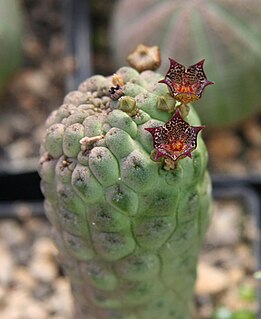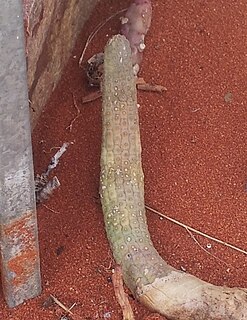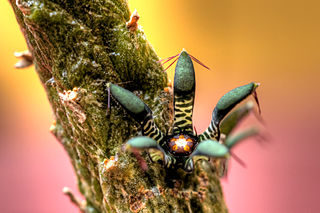This article needs additional citations for verification .(February 2013) (Learn how and when to remove this template message) |
| Larryleachia | |
|---|---|
 | |
| Larryleachia cactiformis | |
| Scientific classification | |
| Kingdom: | Plantae |
| (unranked): | Angiosperms |
| (unranked): | Eudicots |
| (unranked): | Asterids |
| Order: | Gentianales |
| Family: | Apocynaceae |
| Subfamily: | Asclepiadoideae |
| Genus: | Larryleachia Plowes |
| Synonyms | |
LeachiaPlowes (nonCassini) | |
Larryleachia is a genus of stapeliad succulent flowering plants in the family Apocynaceae.

The flowering plants, also known as angiosperms, Angiospermae or Magnoliophyta, are the most diverse group of land plants, with 64 orders, 416 families, approximately 13,164 known genera and c. 369,000 known species. Like gymnosperms, angiosperms are seed-producing plants. However, they are distinguished from gymnosperms by characteristics including flowers, endosperm within the seeds, and the production of fruits that contain the seeds. Etymologically, angiosperm means a plant that produces seeds within an enclosure; in other words, a fruiting plant. The term comes from the Greek words angeion and sperma ("seed").

Apocynaceae is a family of flowering plants that includes trees, shrubs, herbs, stem succulents, and vines, commonly known as the dogbane family,. Members of the family are native to the European, Asian, African, Australian, and American tropics or subtropics, with some temperate members. The former family Asclepiadaceae is considered a subfamily of Apocynaceae and contains 348 genera. A list of Apocynaceae genera may be found here.
- Species [1]
- Larryleachia cactiformis (Hooker) Plowes
- Larryleachia marlothii (N.E. Brown) Plowes
- Larryleachia perlata (Dinter) Plowes
- Larryleachia picta (N.E.Brown) Plowes
- Larryleachia tirasmontana (Plowes) Plowes

Larryleachia cactiformis is a stapeliad succulent, native to Namaqualand in South Africa, where it grows in rocky areas. Larryleachia cactiformis proves as difficult a member of the Apocynaceae family in cultivation as others in its genus.

Larryleachia marlothii is a summer-flowering succulent plant native to Namibia and southern Angola.
Larryleachia tirasmontana is a species of plant in the Apocynaceae family. It is endemic to Namibia. Its natural habitat is cold desert.
- Taxonomy
Phylogenetic studies have shown the genus to be monophyletic, and most closely related to the Richtersveldtia and Notechidnopsis genera of stapeliads. Marginally more distantly related is a sister branch of related genera including Lavrania and Hoodia . [2]
Notechidnopsis is a species of plants in the Apocynaceae first described as a genus in 1985. It contains only one recognized species, Notechidnopsis tessellata , native to Cape Province in South Africa.

Lavrania is a genus of plant in family Apocynaceae, first described as a genus in 1986. It is native to southern Africa.
- Lavrania cactiformis(Hook.) Bruyns
- Lavrania haagneraePlowes - Namibia
- Lavrania marlothii(Marloth) Bruyns - Namibia, South Africa
- Lavrania perlata(Dinter) Bruyns - Great Namaqualand in Namibia
- Lavrania picta(N.E. Br.) Bruyns - Little Namaqualand in Northern Cape Province of South Africa

Hoodia is a genus of flowering plants in the family Apocynaceae, under the subfamily Asclepiadoideae, native to Southern Africa.














